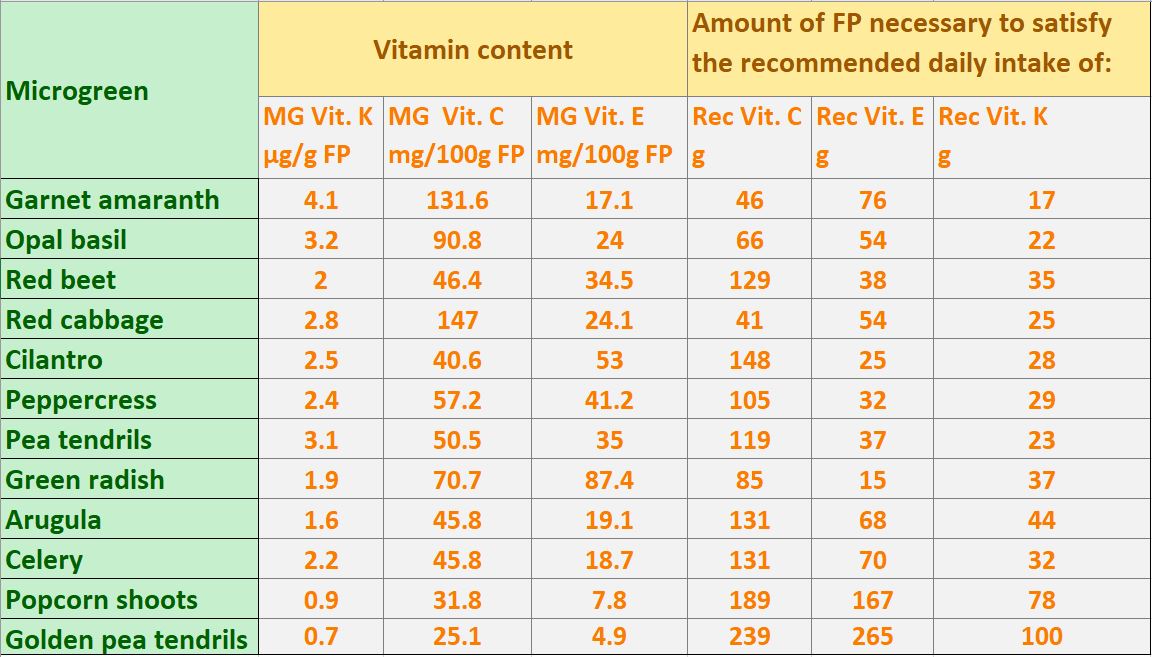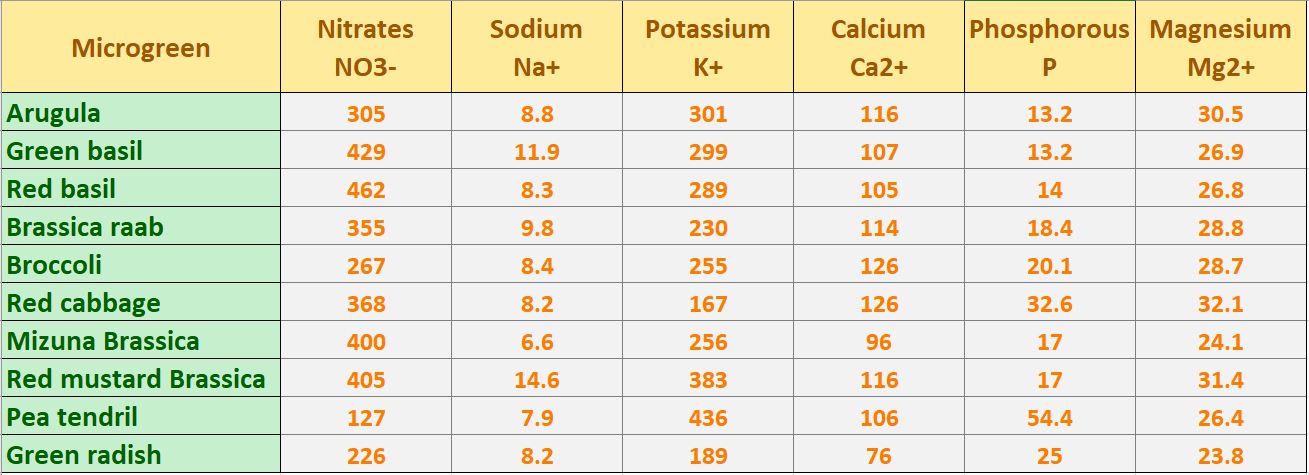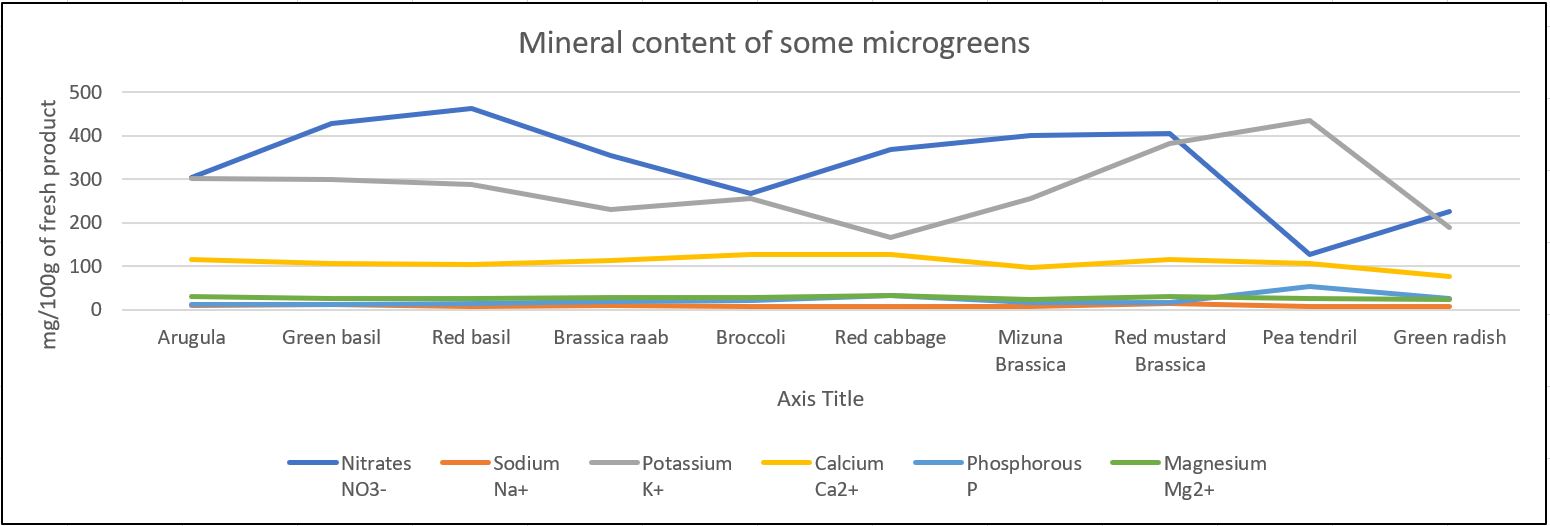Microgreens are, by their very nature – A Super Food – Superb in both flavour and nutritional value.
Oozing with a myriad of health benefits, they fortify and enrich recipes as well as adding colour and splendour to any dish.
The chart below shows nutritional value of microgreens in relation to the recommended daily allowance of vitamins. It is plain to see that just a small amount of microgreens or micro cress holds far more nutritional value than a far greater quantity of the most vitamin-rich vegetables.
Microgreens have entered the mainstream restaurant trade, but there remains a huge lack of understanding among chefs about the most effective usage of products like micro cress, micro herbs, micro greens and speciality leaves, all of which can be cultivated on-site in a Bloomkubes unit.
Micros are very powerful in terms of their flavour, as well as their nutritional value and education is crucial to understanding a product and its usage.
The beauty of Bloomkubes is that they provide a constant supply of live micros, cut when the chef needs them and they really couldn’t be any fresher with zero food miles – Bloomkubes and microgreens grown within them are a truly sustainable option for restaurants looking to vastly reduce their carbon footprint.
Pre-cut microgreens, micros, lose much of their flavour and nutritional value, so a way of growing the varieties that they use the most is very attractive to chefs. In harvesting the micros themselves, chefs develop better appreciation for the usage.
When chefs cut micros as and when required, they can smell the aroma from the freshly-cut herbs. This helps with food-pairing and enables them to create fantastic new dishes for their menus.
World-leading micro cress producer, Koppert Cress, has done a great deal of research into the health benefits of all varieties of micros. Their best-selling BroccoCress, positioned as a fresh superfood.
Fresh broccoli is undoubtedly one of the most noble of vegetables, widely-celebrated for its various health benefits, especially in strengthening the immune system. It is not only incredibly rich in vitamins and minerals, but especially in sulforaphane, a substance which activates antioxidants and enzymes in immune cells.
The cress version of broccoli, just 30g of Broccocress™ contains fifty times more sulforaphane than a complete head of broccoli. Its mild taste renders it a perfect partner with cheese! It is also fantastic garnish to decorate all kinds of dishes and the perfect finishing ingredient for soups and sauces.
For those who may be convalescing from an illness, Brococress™ could be used to fortify and add flavour to food to aid them in their journey of recovery.
A group of researchers of the U.S. Department of Agriculture (USDA) and the University of Maryland, analysing the concentration of vitamins (Vitamin C, E and K) and ca-rotenoids (β-carotene, lutein and zeaxanthin) in twenty five varieties of microgreens, demonstrated that as compared, microgreens have ten times the content of antioxidant compounds when compared to regular vegetables, harvested at the standard commercial ripening stage.
According to the research summary
According to Table-1, In the case of the red cabbage, comparing the amount of the above-mentioned vitamins in the microgreens with those reported in the literature for the same species harvested at a regular ripening stage, microgreens showed an average content of Vitamin C is six times higher (147 vs 23.5 mg/100 g of fresh product – FP) a four hundred times higher value of Vitamin E (24.1 vs 0.06 mg/100 g of FP) and a sixty times higher content of Vitamin K (2.4 vs 0.04 µg/g of FP) (Xiao et al., 2012).
Considering the daily intake levels recommended by the European Food Safety Authority (EFSA) for Vitamin C (60 mg), Vitamin E (13 mg) and Vitamin K (70 µg) for an adult of medium weight, given the content of Vitamin C, E and K estimated in the same study, for some of the species analysed it is possible to demonstrate that even few grams of microgreens can entirely satisfy the recommended daily intake of these three vitamins as shown in Tabel-1

Table 1 – Contents of ascorbic acid (vitamin C), α-tocopherol (vitamin E) and phylloquinone (vitamin K) in some species of microgreens and relative amount of fresh product (FP) necessary to satisfy the recommended daily intake of each vitamin for an adult
- From chart-1, we can see that Red cabbage and Garnet amaranth is rich in Vitamin C, Cilantro/Coriander and Green daikon radish is rich in Vitamin E and there is sufficient nutrition as per recommended daily intake.

Chart-1, comparison of vitamin C & E in popular microgreen as well recommended daily intake by EFSA- European Food Safety Authority. *FP = Fresh Product.
Analysing the content of the main minerals in few microgreens, it is possible to observe that microgreens represent a good source of potassium and calcium (Table 2).

Table 2- Analysing mineral content in fresh popular microgreen

Chart-2 Mineral content of popular microgreens.
In addition to the high content of vitamins and anti-oxidant compounds, microgreens have a good content of minerals too.(Di Gioia et al., 2015).
Nevertheless, like other leafy vegetables, microgreens may be characterized also by a high content of nitrates which are considered anti-nutritional factors (Di Gioia et al.,2013; Santamaria, 2006).
Analysing more closely the mineral composition of several microgreens, we can notice that, especially for basil and the Brassicaceae, in presence of exceeding supply of nitric nitrogen and under low levels of sunlight, the content of nitrates can increase over 4,000 mg/kg of fresh product (Table 2).
On the contrary, the content of sodium seems to be generally very low (Table 2). Thus, microgreens can also be considered low sodium foods.
Controlling Nutrition in Microgreens for focused health benefit.
The content of minerals in microgreens is strongly determined by the availability of the same minerals in the growing media or in the nutrient solution provided.
Therefore, it is possible to obtain microgreens with a high content of essential macro- and micro-elements or with a low content of undesired elements such as nitrates and sodium, by modifying the composition and the management of the nutrient solution.
For those with impaired kidney function, it is of course prudent to recommend a restriction of high-potassium foods.
Researchers experimented with reduction of potassium in microgreens by reducing the potassium concentration in the nutrient solution, without negatively affecting the proximate composition.
Unlike conventional vegetables, the microgreens that were produced in the present study could reduce the potassium intake in patients with impaired kidney function who were accustomed to eating vegetable-based dishes.
This further proves the case for acquiring essential/controlled nutrients and minerals from microgreens in accordance with patient need.
As a summary Microgreen is a super food for health-conscious body and mind and a fantastic flavour and visual enhancer for chefs in the professional kitchen.
References:
- https://www.ncbi.nlm.nih.gov/pmc/articles/PMC6024851/
- Francesco Di Gioia, Pietro Santamaria. The Nutritional properties of microgreens, Pennsylvania State University. https://www.researchgate.net/publication/305175608_The_nutritional_properties_of_microgreens


Leave a Reply